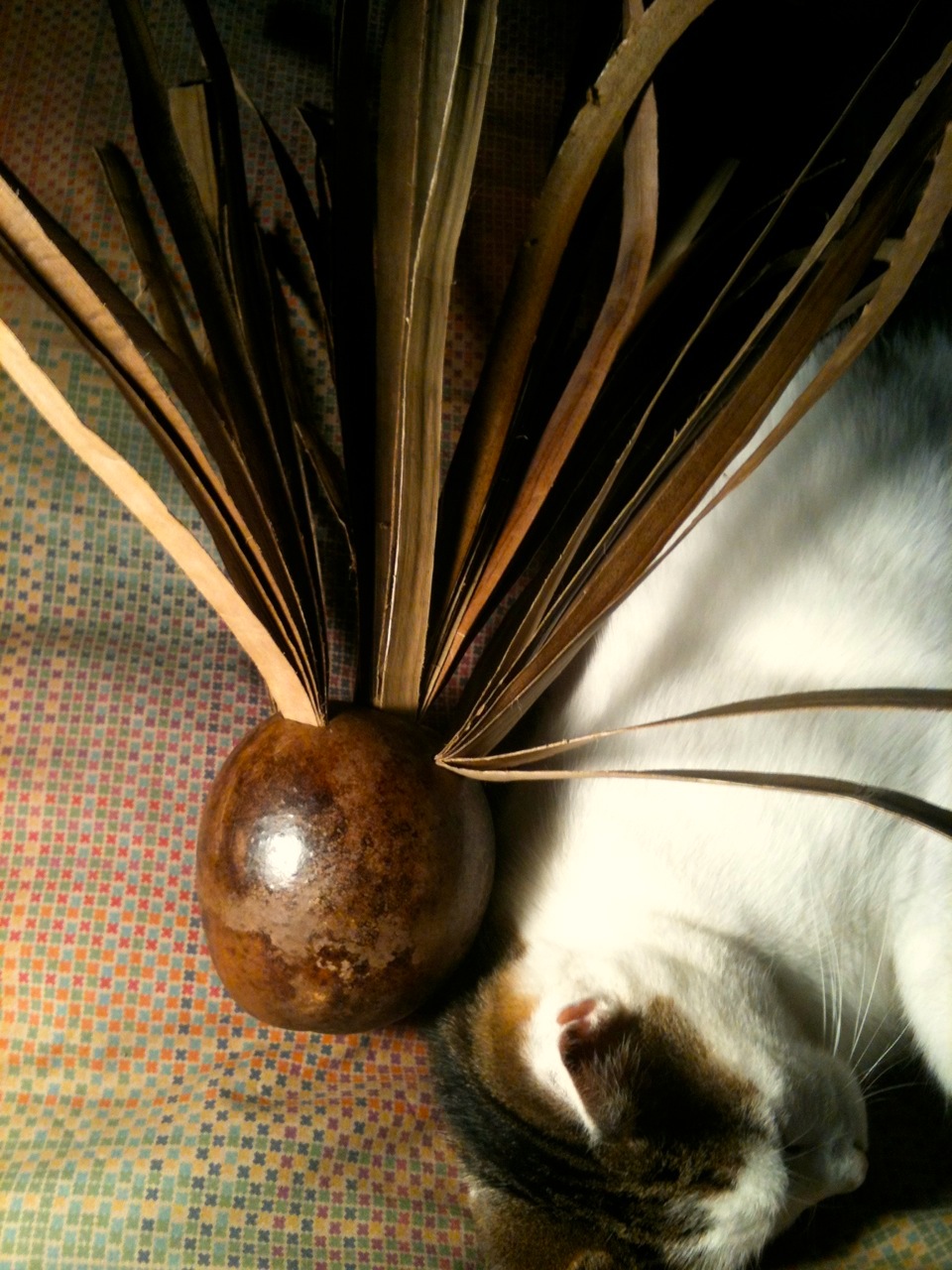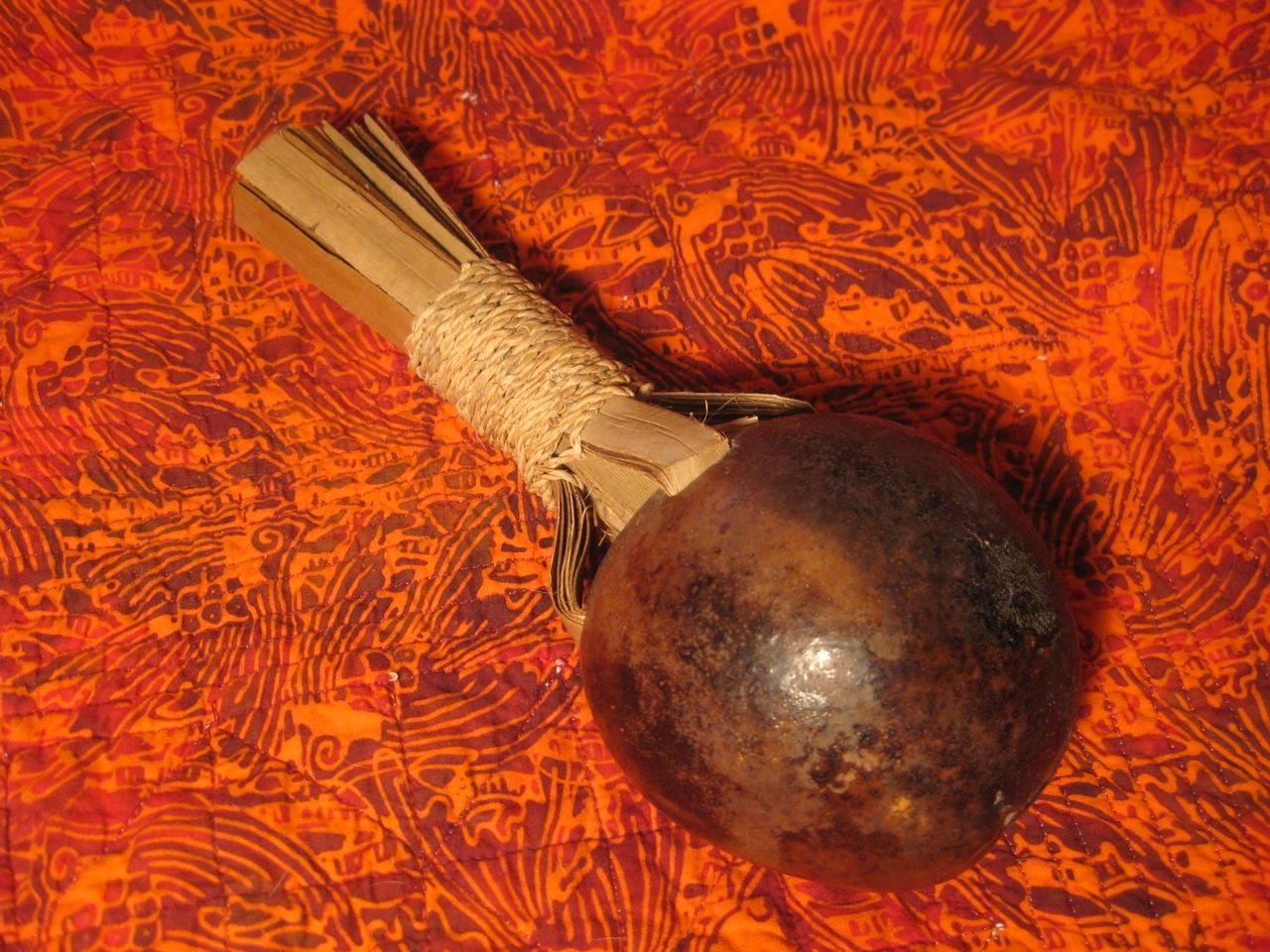Category Archives: Music
Merrie Monarch: Cultural Traditions
I’m not a hula person, but my daughter is and this year is the first year she’s dancing in the annual Merrie Monarch hula festival. If you live in Hawai‘i, you know that’s a big deal here. It’s a hula competition held every spring in Hilo, and it’s one that people come to from around the world.
Somehow that managed to skip a couple generations, but I love that once again, this house is sometimes filled with hula and ‘oli (chanting), and that rolls of lau hala and skeins of handmade hau cordage and handmade hula implements, like this ‘ulī‘ulī we made, again fill our home.
Merrie Monarch 2011
Hilo just finished hosting hula dancers and admirers from around the world at its annual Merrie Monarch hula festival.
It’s so great to see how Hilo comes alive for that Merrie Monarch week, which is held each year around Easter. The streets overflow with people, many of them Hawaiian, in their designer aloha wear, flower leis and lauhala hats. Everything that is good about the place — the people, the leis, the music, the dancing — is magnified and multiplied. It’s everywhere. It’s wonderful.
From Wikipedia:
The Merrie Monarch Festival is a week-long cultural festival that takes place annually in Hilo, Hawaii. It honors King David Kalākaua, who was called the “Merrie Monarch” for his patronage of the arts. He is credited with restoring many Hawaiian cultural traditions during his reign, including the hula. Many hālau hula (schools), including some from the U.S. mainland and Japan, attend the festival each year to participate in the festival exhibitions and competitions, which are considered the most prestigious of all hula contests. Read the rest
The hula always starts on Wednesday, with a free Ho‘ike (demonstration) night. Watch this year’s Ho‘ike highlights from Big Island Video News here, and some of Halau O Kekuhi’s dances from that night here. They are renowned, and what a treat to see them.
Some other videos from this year’s Merrie Monarch:
This is Halau Hula O Kahikilaulani, of Hilo (It’s their kahiko performance)
Chinky Mahoe’s Kawaili‘ula, from Kailua, O‘ahu (kahiko)
And there’s always a wonderful Merrie Monarch Parade through Hilo town. See some of that here: 2011 Merrie Monarch Festival Grand Parade
It’s never too soon to start thinking about attending Merrie Monarch the next year, if you’re interested. Mark your calendars: tickets are available to purchase by mail only, and your ticket requests must be postmarked on December 26 or later. (If they are mailed later, you might not get seats; it’s best if you email your request on 12/26 exactly.)
Ticketing info is not yet updated for the 2012 festival, but watch this space later in the year if you’re interested in knowing exactly how to order.
Slack Key Class
Richard asked Macario to say a few words about the slack key guitar class they both took recently, which was taught by slack key master Cyril Pahinui.
The class, held at the University of Hawai‘i at Hilo, was popular — so many signed up that they had to split the group into two different classes.
Macario says it was Richard’s “fault” he was there. “Richard told me about this class coming up, and I signed up at the very last minute. It was fun taking the class with a friend. We were having so much fun, we wouldn’t play we would just listen. You get caught up when he starts to play, and we’d just put our guitars down and listen to him playing.”
“Richard was into it,” he says. “Both of us were. He and I were just like two little kids at a candy store. It was great.”
Macario was a professional musician in his “former life” — a couple decades ago, before changing careers and becoming a photographer. But he played drums, not guitar, and says he always wanted to learn slack key.
“It’s more than just playing the music,” he says. “There’s a feeling to the music. Cyril kept saying, ‘Don’t play how I play. Play how you feel.’ Because when you’re playing, and you’re in that groove, then something happens. Because you can move people.”
Cyril’s father was the late great Gabby Pahinui, the legend in Hawaiian slack key, and he learned to play guitar from his father since he was a young boy.
Macario says Cyril taught his father’s tuning — the way he tuned his guitar. In older days, this information was private and never shared. So why does Cyril teach it now?
Cyril told the class he likes to pass it on. “He said if he doesn’t teach anybody, and nobody carries it on after him, then he’s going to lose it.”
Macario says he’d definitely take a class from Cyril again. “There’s so much coming at you. I think it made the beginners a little scared. But it’s good for them. It’s good for them to see we can all do this. All you have to do is work at it. If you practice everything he taught you in this class, then when he comes back to teach the next one you’ll be ready for that class.”
“The music is just in him,” he says. “And in class, he’s coming at ya. It’s a lifetime, two lifetimes of music coming at you, and you’d better pick up what you can because you’ve only got six classes to do it.”
He says he’s still trying to find his way around his guitar. “But everything Cyril taught us just makes sense,” he says. “If you practice what Cyril taught in that class, you can pretty much play any Hawaiian song. And not only did Cyril teach the class, he made people go up and jam with him. How many chances do you get to play with Cyril Pahinui?”
He says the class was a nice surprise. “Before, his dad just overshadowed everything because he was so great. But Cyril is on his own and carrying on the tradition even without his dad.
“And Cyril himself is ‘the man’ now,” he says. “He’s the icon now. He is a great slack key player in his own right.”
Slack Key Class
Last night was the second of my slack key guitar lessons with Cyril Pahinui. I still can’t believe it. At the first session we received some papers with basic chords on them and then the rest of the class was a talk-story, one-man jam session. We were the audience.
Cyril would play a song and then talk about the old days with his Pop, Gabby Pahinui, and the people who came over to their house in Waimanalo to jam. They were all there. Atta Isaacs, Sonny Chillingworth, Peter Moon, Kui Lee—they would all drop by. And then he would play another song. Without realizing it, the class was getting a feel for the music.
Cyril said his father, Gabby, never sat down to teach him a chord or show him how to play. He just told Cyril to watch and listen. And he did. Eventually Cyril would get to accompany the guys in the background. He said he would wait and wait for somebody to say: “Okay, boy. You take ‘em.” Then he would play the lead for one turn. That was the highlight for him.
At the start of last night’s class, Cyril said that the earlier class—all 37 students—was able to play two songs when they went home. He handed out sheets of paper with the words to the songs Puamana and Kaulana Kawaihae. He played and sang them once and told us where to write the chord changes. Then we all played it together a few times. In a short time, we had enough of it to go home and be able to get a lot better with practice.
I’m going to take out my guitar now….
Farm Aid
Last night’s Farm Aid concert took place in New York City.
Remember Farm Aid? The first annual Farm Aid concert, organized by Willie Nelson, Neil Young and John Mellencamp, was in 1985. Since then, the musician Dave Matthews has also joined the board. The nonprofit organization (mission: to keep family farmers on their land) has raised more than $30 million to “promote a strong and resilient family farm system of agriculture.”
I enjoyed this New York Times article for quotes like this one, from Willie Nelson.
For Mr. Nelson, Farm Aid’s ideals are a reminder of his childhood in Abbott, Tex. “We had organic food and didn’t know it for a long time,” he said. “It tasted great, and we only know that we grew it out in the back garden, and we had a lot of great potatoes and tomatoes and all our own vegetables. Then I left home to go on the road and I couldn’t find that food any more.”
The article goes on to say that there will be no “factory-farmed junk food” sold at the concert. All food offered at the 25,000-capacity venue will be from family farms.
“People have to take over their own food supply,” Mr. Nelson said. “They have to make sure whatever they eat is healthy and do whatever it takes to do that: shopping locally, farming locally, consuming locally.”
And I liked reading this, too, which is something we talk about here a lot:
Why New York? The city brings renewed news media attention to the long-running event, of course. Farm Aid was also invited here, said its executive director, Carolyn Mugar, by an assortment of environmentalists, politicians (including the mayor’s office) and chefs. Over the years Farm Aid has become part of what’s known as the Good Food Movement, alongside organizations working from various angles to roll back industrial farming and promote organic and sustainable food production — and consumption. While the city itself may not be farm country, it’s full of people who eat.
“Farmers are never going to survive if they don’t have as allies the people who want this good food,” Ms. Mugar said. “New York has a huge density of eaters and a density of people who are doing excellent things. There are restaurants, farmers’ markets, community-supported agriculture programs, even people who are growing food in the city and teaching people how to grow it.”
The Farm Aid website talks about how to find Good Food, as the organization defines it. Worth checking out.


